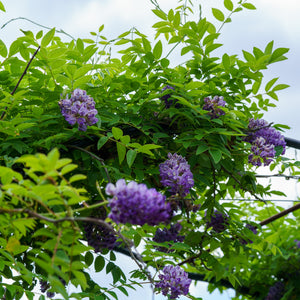The Wisteria Guide
Wisteria is a fast-growing, long-lived flowering vine known for its cascading clusters of fragrant, pea-like flowers and dramatic architectural presence. Grown on arbors, pergolas, walls, or fences, wisteria brings a romantic elegance to gardens in spring and early summer. With proper training and care, it becomes a stunning focal point in both formal and informal landscapes.

About
Wisteria belongs to the legume family (Fabaceae) and includes several species native to Asia and North America. It is best known for its striking floral displays, which range in color from violet and purple to white and soft pink, depending on species and cultivar.
Common types include:
- Wisteria floribunda (Japanese Wisteria): Known for its long, pendulous flower clusters and vigorous growth. Cultivars include 'Royal Purple' and 'Kuchibeni'.
- Wisteria sinensis (Chinese Wisteria): Also vigorous, with slightly shorter flower racemes and counterclockwise twining habit.
- Wisteria frutescens (American Wisteria): A native species with more restrained growth and earlier bloom time. 'Amethyst Falls' and 'Longwood Purple' are popular cultivars.
- Wisteria macrostachya (Kentucky Wisteria): Cold-hardy and less aggressive than Asian types, with cultivars like 'Blue Moon' known for repeat blooming.
Wisteria can grow 15 to 30 feet or more in length, depending on variety and support. It is renowned for its longevity and can live for decades with proper care.
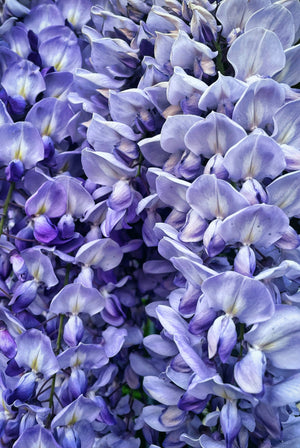
PLANTING
USDA Hardiness Zones: Most wisteria varieties are hardy in Zones 5–9, though some types (e.g., Wisteria macrostachya) can tolerate Zone 4.
Soil: Prefers well-drained, fertile soil. Tolerates clay and loam but should not sit in waterlogged conditions. Slightly acidic to neutral pH is ideal.
Sunlight: Full sun is essential for abundant flowering. Provide at least 6 hours of direct sunlight per day.
Watering: Moderate water needs. Water regularly during establishment and in dry periods. Once established, wisteria is drought-tolerant.
Spacing: Space plants 10 to 15 feet apart to allow for full spread and airflow.
Planting Time: Plant in spring or fall. Container-grown plants can be planted throughout the growing season with proper watering.
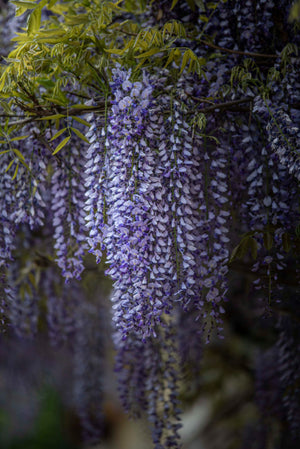
CARE
Watering: Keep soil evenly moist but not soggy, especially during the first year. Mature plants tolerate dry spells but bloom better with regular moisture.
Fertilizing: Avoid high-nitrogen fertilizers, which promote foliage over flowers. Use a low-nitrogen fertilizer or none at all once established.
Pruning: Prune twice yearly—once in midsummer (July or August) to trim current season’s growth and again in late winter to refine structure and promote blooming. Remove suckers and tangled growth regularly.
Training: Wisteria must be trained onto a sturdy support. Use strong arbors, pergolas, or trellises, and tie young vines to guide them as they grow.
Pests and Diseases: Wisteria is relatively pest-free but can experience aphids, scale, or fungal leaf spots. Ensure good airflow and avoid overwatering.
Mulching: Mulch annually to conserve moisture and suppress weeds, keeping mulch a few inches away from stems.
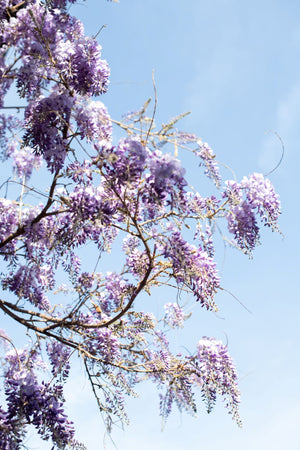
HOW TO USE
Pergolas and Arbors: Train wisteria up and over structures for a dramatic floral canopy in spring. Ensure the structure is strong enough to support mature vines.
Walls and Fences: Espalier or train along fences and masonry walls to add height, privacy, and seasonal beauty.
Garden Entrances: Frame doorways, archways, or garden gates with cascading flowers for a welcoming effect.
Containers (Dwarf Varieties): Compact types like 'Amethyst Falls' can be grown in large containers with support. Ideal for patios and small-space gardens.
Wildlife Gardens: The flowers attract pollinators including bees and butterflies. Plant near other pollinator-friendly species such as salvia, phlox, and lavender.
Focal Point Plantings: Few plants rival wisteria for sheer drama when in full bloom. Use it as a focal point on a pergola or trained over a prominent entry.
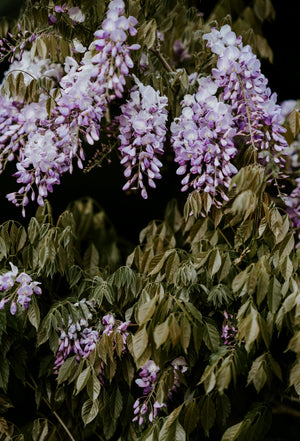
Common Questions
Is wisteria poisonous to dogs or cats? Yes, all parts of the wisteria plant are toxic if ingested by dogs, cats, or humans. The seeds and pods are especially dangerous.
Do deer eat wisteria? Wisteria is generally deer resistant, though young shoots may be browsed occasionally.
Do rabbits eat wisteria? Rabbits may chew on tender new growth, but wisteria is not a preferred food source.
When does wisteria bloom? Most wisteria bloom in mid to late spring. Some varieties, like 'Blue Moon', may rebloom in summer.
How to propagate wisteria? Propagate by softwood cuttings in summer, hardwood cuttings in fall, or by layering. Seed propagation is possible but slow and unreliable for named cultivars.
How to grow wisteria? Plant in full sun, provide a strong support structure, and prune regularly to establish a flowering framework.
When to prune wisteria? Prune in midsummer to control growth and again in late winter to shape and encourage blooms.
How fast does wisteria grow? Wisteria is a vigorous grower, often adding 10 feet or more of growth per year under ideal conditions.
Does wisteria need full sun? Yes. Full sun is required for best flowering. In shaded areas, foliage will grow but blooming may be sparse.
Conclusion
Wisteria brings breathtaking beauty and structural presence to the garden with its trailing flowers and vigorous habit. While it requires pruning and patience to train, its cascading blooms and striking form make it one of the most rewarding vines for experienced and aspiring gardeners alike. Choose from native or non-invasive varieties, give it space and sunlight, and enjoy decades of floral drama and seasonal charm.
The Wisteria Collection
Sold Out

